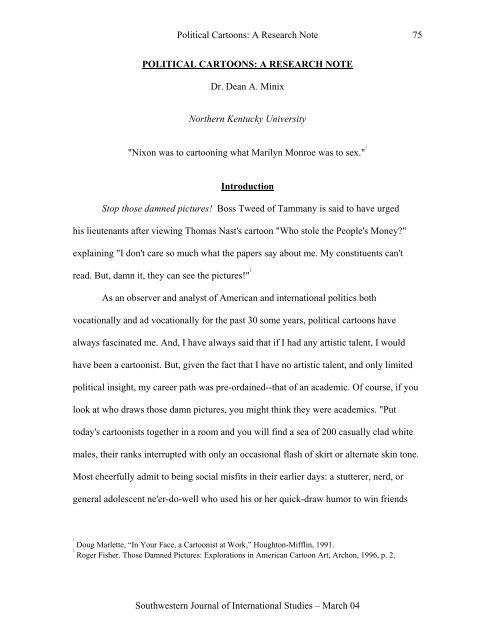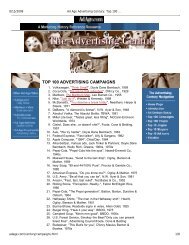Political Cartoons: A Research Note 75 Southwestern Journal of ...
Political Cartoons: A Research Note 75 Southwestern Journal of ...
Political Cartoons: A Research Note 75 Southwestern Journal of ...
You also want an ePaper? Increase the reach of your titles
YUMPU automatically turns print PDFs into web optimized ePapers that Google loves.
<strong>Political</strong> <strong>Cartoons</strong>: A <strong>Research</strong> <strong>Note</strong> <strong>75</strong><br />
POLITICAL CARTOONS: A RESEARCH NOTE<br />
Dr. Dean A. Minix<br />
Northern Kentucky University<br />
"Nixon was to cartooning what Marilyn Monroe was to sex." 1<br />
Introduction<br />
Stop those damned pictures! Boss Tweed <strong>of</strong> Tammany is said to have urged<br />
his lieutenants after viewing Thomas Nast's cartoon "Who stole the People's Money"<br />
explaining "I don't care so much what the papers say about me. My constituents can't<br />
read. But, damn it, they can see the pictures!" 2<br />
As an observer and analyst <strong>of</strong> American and international politics both<br />
vocationally and ad vocationally for the past 30 some years, political cartoons have<br />
always fascinated me. And, I have always said that if I had any artistic talent, I would<br />
have been a cartoonist. But, given the fact that I have no artistic talent, and only limited<br />
political insight, my career path was pre-ordained--that <strong>of</strong> an academic. Of course, if you<br />
look at who draws those damn pictures, you might think they were academics. "Put<br />
today's cartoonists together in a room and you will find a sea <strong>of</strong> 200 casually clad white<br />
males, their ranks interrupted with only an occasional flash <strong>of</strong> skirt or alternate skin tone.<br />
Most cheerfully admit to being social misfits in their earlier days: a stutterer, nerd, or<br />
general adolescent ne'er-do-well who used his or her quick-draw humor to win friends<br />
1<br />
Doug Marlette, “In Your Face, a Cartoonist at Work,” Houghton-Mifflin, 1991.<br />
2<br />
Roger Fisher, Those Damned Pictures: Explorations in American Cartoon Art, Archon, 1996, p. 2.<br />
<strong>Southwestern</strong> <strong>Journal</strong> <strong>of</strong> International Studies – March 04
<strong>Political</strong> <strong>Cartoons</strong>: A <strong>Research</strong> <strong>Note</strong> 76<br />
and gain notoriety." 3 Perhaps cartoonists, like some academics, are like the boy with the<br />
brick--just waiting to flail it threw the first plate glass window they find. "Good cartoons<br />
are like visual rock and roll, writes Newsday cartoonist Doug Marlette. "They hit you<br />
primitively and emotionally. There is something wild and untamed about the best <strong>of</strong><br />
them, raw and vaguely threatening like Little Richard or Jerry Lee Lewis…. A cartoon<br />
cannot say, 'On the other hand.' And it cannot defend itself. It is a frontal assault, a slam<br />
dunk, a cluster bomb." 4<br />
Cartoonists today, like days <strong>of</strong> yore, come from different political persuasions and<br />
sociological heritages. Today, however, most cartoonists are liberal democrats, but in the<br />
nineteenth century, the opposite was the case. Whatever their perspectives, cartoonists<br />
are political lampoonists who produce a subjective view <strong>of</strong> their Weltanschauung. The<br />
most important part <strong>of</strong> any cartoon is the idea that drives or motivates it. "Rollin Kirby,<br />
one <strong>of</strong> the finest American newspaper cartoonists <strong>of</strong> the 20 th century, said that a good<br />
cartoon consists <strong>of</strong> <strong>75</strong>% idea and 25% drawing. 'A good idea has carried many <strong>of</strong><br />
indifferent drawing to glory,' commented Kirby in 1918, 'but never has a good drawing<br />
rescued a bad idea from oblivion." 5<br />
A cartoonist's job is to attack--to lampoon. They do this through the convention<br />
<strong>of</strong> satire. Cartoonists do not present the daily news. They interpret the daily news. "As<br />
Chicago Tribune cartoonist Jeff MacNelly has said, 'A political cartoon is not like a<br />
truckload <strong>of</strong> tomatoes in 90 degree weather. It isn't<br />
3<br />
Stephen Hess and Sand Northrop, Drawn and Quartered: The History <strong>of</strong> American <strong>Political</strong> <strong>Cartoons</strong>,<br />
Montgomery: Elliot and Clark, 1996, p. 10.<br />
4<br />
Ibid., p. 10.<br />
5<br />
Ibid., p. 11.<br />
<strong>Southwestern</strong> <strong>Journal</strong> <strong>of</strong> International Studies – March 04
<strong>Political</strong> <strong>Cartoons</strong>: A <strong>Research</strong> <strong>Note</strong> 77<br />
something that has to be delivered the next day.'" 6 Most good cartoons attack; only the<br />
vary rare cartoons applaud something like a peace treaty. It's like Walter Cronkite said<br />
about the definition <strong>of</strong> news, "it’s news if it's out <strong>of</strong> the ordinary." On an aside, why we<br />
consider peace to be the norm, and conflict to be the aberration, I will never understand.<br />
Recorded human history does not give that accounting.<br />
In his perceptive analysis <strong>of</strong> Nast's effectiveness in The<br />
<strong>Political</strong> Cartoon, Charles Press stressed the shock value <strong>of</strong> raw<br />
emotional impact: The Nast cartoon is great because <strong>of</strong> the emotional<br />
impact <strong>of</strong> its presentation. It continuously goes beyond the bounds <strong>of</strong><br />
good taste and conventional manners. Nast is like the man who rings<br />
your bell and, when you open the door, guns in shouting insults at you<br />
and throwing rocks and mud at you and your wife and on your front<br />
hall walls. Your reaction is that what excites him must be a grievous<br />
wrong you somehow unwittingly committed. 7<br />
Do cartoons peddle the truth, or are they as fallible as their authors Well,<br />
obviously the answer to this question is indeed one <strong>of</strong> perspective. Where one stands<br />
determines what he will see. <strong>Cartoons</strong> are propaganda. But, remember the root meaning<br />
<strong>of</strong> propaganda is information. The question is information decoded by whom and for<br />
what purposes. Pat Oliphant, one <strong>of</strong> the most outspoken cartoonists in articulating the<br />
need to use the cartoon for critical comment…states that 'our business is valuable enough<br />
to be looked upon as a<br />
6<br />
Ibid., p. 14. 7 Fischer, op. cit., p. 14.<br />
<strong>Southwestern</strong> <strong>Journal</strong> <strong>of</strong> International Studies – March 04
<strong>Political</strong> <strong>Cartoons</strong>: A <strong>Research</strong> <strong>Note</strong> 78<br />
leading vehicle for printed and savage opinion and someone will always be<br />
<strong>of</strong>fended.'" 8<br />
"From the little we do know about the psychology <strong>of</strong> political behavior, it is likely<br />
that those cartoons most effective as propaganda have tended not to confront and to<br />
challenge but rather to reinforce and build on a priori beliefs, values, and prejudices.<br />
Andrew Jackson and William Henry Harrison as frontier farmer-warriors and Abraham<br />
Lincoln as the 'rail-splitter <strong>of</strong> the West' were served superbly by images <strong>of</strong> rustic virtue<br />
and primal vigor conforming so well to the popular mythic ideal <strong>of</strong> the western<br />
wilderness, just as John Quincy Adams in 1828 and Martin Van Buren in 1840 fell victim<br />
to outlandish smear campaigns, mainly because as small, balding men <strong>of</strong> ideas, they<br />
epitomized East and Europe. The 1964 LBJ countdown television ads, and Roger Ailes's<br />
masterful 1968 Nixon media campaign and the1988 Willie Horton spot, become the stuff<br />
<strong>of</strong> Madison Avenue legend. They were successful not because they inspired the millions<br />
to behold Barry Goldwater, Hubert Humphrey, and Michael Dukakis in alarming new<br />
lights, but because they were built upon existing fears that Goldwater was a reckless warhawk<br />
and the Humphrey and Dukakis were both 's<strong>of</strong>t on crime' and pandering to minority<br />
ghetto voters." 9<br />
As Roger Fischer writes,<br />
8<br />
Ibid., p. 21.<br />
<strong>Southwestern</strong> <strong>Journal</strong> <strong>of</strong> International Studies – March 04
<strong>Political</strong> <strong>Cartoons</strong>: A <strong>Research</strong> <strong>Note</strong> 79<br />
By its very nature, political cartoon art in a democratic society has been<br />
one <strong>of</strong> the purest artifacts <strong>of</strong> popular culture, seeking to influence public<br />
opinion through its use <strong>of</strong> widely and instantly understood symbols,<br />
slogans, referents, and allusions. The artist must exploit conventions in<br />
fundamental harmony with the 'cultural literacy' <strong>of</strong> the public or risk<br />
almost certain failure, for obscurity and snob humor are fatal to the<br />
medium. Thus the context <strong>of</strong> the effective editorial cartoon, disregarding<br />
altogether its ideology or the issue at hand, can tell us much about the<br />
popular culture <strong>of</strong> its day. 10<br />
The American Industrial Revolution was the watershed event that promoted what<br />
we now call American popular culture. While early cartoons reflected a rather traditional<br />
cultural heritage with referents to the Bible, the mythology <strong>of</strong> Homer, the Renaissance,<br />
Shakespeare, etc., the 20 th century saw an erosion <strong>of</strong> these and similar referents for<br />
caricature. Today's popular culture evokes symmetry with television and Hollywood<br />
characters. Sports analogies are also prevalent. Walt Disney and comic books provide<br />
good grist.<br />
Effective cartooning requires savagery. "Mike Peters once stated, 'cartooning is<br />
not a fair art. You can never treat anyone justly, adding that most cartoonists like me--<br />
who like to attack--are the loaded guns.' Louisville Courier <strong>Journal</strong> mainstay Hugh<br />
Haynie has defined the cartoon as 'an <strong>of</strong>fensive thing' and Bill Mauldin characterized his<br />
calling as 'a destructive art,' insisting that the proper function <strong>of</strong> cartoonists is not to act as<br />
'pontificators, or molders <strong>of</strong> thought' but rather as gadflies who 'circle and stab, circle and<br />
stab.' Jules Feiffer voiced a<br />
9<br />
Fisher, op. cit., p. 15. See also, Joe McGinnis, The Selling <strong>of</strong> the President, 1968, New York, 1969, and<br />
<strong>Southwestern</strong> <strong>Journal</strong> <strong>of</strong> International Studies – March 04
<strong>Political</strong> <strong>Cartoons</strong>: A <strong>Research</strong> <strong>Note</strong> 80<br />
belief that 'outside <strong>of</strong> basic intelligence, there is nothing more important to a good<br />
political cartoon than ill will.' Bill Watterson argued that the cartoonist's role in our<br />
political process 'is not so much to instruct his audience, or illuminate the Truth, as it is to<br />
simply take an honest stand and present it vehemently enough so that it must be<br />
confronted.' Chicago Tribune artist Jeff MacNelly once quipped, 'many cartoonists would<br />
be hired assassins if they couldn't draw.'" 11<br />
As for me, please don't stop those damn pictures. I love them. I envy the talent<br />
and insight that these graphic artists bring to the political dialog--as long as they agree<br />
with me!<br />
Gordon W. Allport and Leo Postman, The Psychology <strong>of</strong> Rumor, New York, 1947.<br />
10<br />
Fischer, op. cit., p. 122.<br />
11<br />
Fischer, op. cit., p. 16-17.<br />
<strong>Southwestern</strong> <strong>Journal</strong> <strong>of</strong> International Studies – March 04
<strong>Political</strong> <strong>Cartoons</strong>: A <strong>Research</strong> <strong>Note</strong> 81<br />
Bibliography<br />
Allport, Gordon, and Leo Postman. 1947. The Psychology <strong>of</strong> Rumor. New York.<br />
Fisher, Roger. 1996. Those Damned Pictures: Explorations in American<br />
Cartoon Art. Archon.<br />
Hess, Stephen, and Sand Northrop. 1996. Drawn and Quartered: The History <strong>of</strong><br />
American <strong>Political</strong> <strong>Cartoons</strong>. Montgomery: Elliot and Clark.<br />
Marlette, Doug. 1991. In Your Face, a Cartoonist at Work. Houghton-Mifflin.<br />
McGinnis, Joe. 1969. The Selling <strong>of</strong> the President, 1968. New York.<br />
<strong>Southwestern</strong> <strong>Journal</strong> <strong>of</strong> International Studies – March 04





![Graduate Bulletin [PDF] - MFC home page - Appalachian State ...](https://img.yumpu.com/50706615/1/190x245/graduate-bulletin-pdf-mfc-home-page-appalachian-state-.jpg?quality=85)











